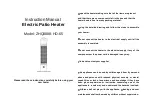
5
I N S TA L L AT I O N
The installation instructions provide a general guideline for the installation and wiring of the heater.
All applicable local codes must be adhered to.
M E C H A N I C A L
L O C AT I O N
For optimum heating, the heater should be installed as follows:
1. There are no obstructions that may impede the heater’s air
inlet or discharge.
2. The air discharge is directed into open areas and not
at occupants.
3. The air discharge is not directed at a thermostat.
4. The air discharge is directed across areas of heat loss, such
as doors and windows (see Figure 2).
5. The air discharge is directed along and at a slight angle
toward exterior walls (see Figure 2).
6. If equipment freeze protection is important, direct air
discharge at equipment.
7. Air discharge streams support each other and create a
circular air flow. It is not required that the heater’s air
throw reaches the next heater (see Figure 2).
FIGURE 2
T R O U B L E S H O O T I N G T I P S
1.0 Heater is not operating
1.1 Check all fuses in heater control box.
1.2 Check remote disconnect switch and circuit breaker.
1.3 Check voltage supplied to the heater – refer to the heater data plate for voltage requirements.
1.4 Check thermostat by turning it and check continuity with a multimeter.
1.5 Verify that there is a jumper wire present between terminals 5 and 6 on the terminal block located in the control box.
2.0 Contactor is chattering
2.1 Check supply voltage.
2.2 Check wiring connections. Tighten all loose electrical connections.
2.3 Check thermostat for continuity (See 1.4). If thermostat does not break continuity replace thermostat.
3.0 Contactor is burned or welded
3.1 Check the contactor for burn marks and blackening. Replace the contactor.
3.2 Check incoming power to the heater to ensure there are no voltage fluctuations.
4.0 Heat exchanger is dirty
4.1 Clean the heat exchanger using compressed air.
5.0. PRV has released
5.1 If there are signs that the PRV has released fluid, PRV indicator is broken, blackening around the PRV exit hole, or
there are fluid stains visible on the top louver, shut the unit down immediately.
5.2 Check for restricted air flow, bad motor, broken thermostat or malfunctioned high limit.
6.0 Heater is cold on top and warm on bottom
6.1 The core may have lost its vacuum. Check the PRV for signs of loss of fluid and verify that the PRV label indicator is
not broken. If PRV has released, send the unit in for repair or replace the core.
6.2 If the PRV does not indicate loss of fluid, the heater should operate normally. Check for loss of fluid on a weekly basis
as a minimum.
6.3 The ambient temperature may be too low. If the ambient temperature is very cold the top of the core will be colder
than the bottom – this is normal.
7.0 Unit cycles on high limit – unit turns on and turns off within less than 5 minutes.
7.1 Check and see if the PRV has released fluid. Core may have lost most or all of its fluid. If PRV has released, send the
unit in for repair or replace core.
7.2 The core may be dirty, fan may not be working or may be turning the wrong way (the fan must rotate clockwise as
seen from the front of the unit) objects may be stuck in the heat exchanger for drying or warming up – remove any
items from the exchanger.
8.0 The Ground Fault Interrupter (GFI) trips on the main panel, or heater blows fuses.
8.1 Check that you have a fuse of the proper amperage rating.
8.2 Check for loose or frayed wiring.
8.3 If condition is not observable, send heater in for repair.
8.4 Change sensitivity of GFI.
9.0 The fan is turning but very little air comes from the front of the heater.
9.1 Check fan rotation and ensure that the fan turns clockwise as seen from the front of the heater. Refer to the Installation
section below for more information.
9.2 Check motor winding resistance and verify that they are balanced.
9.3 Check fan blade set screws to ensure fan blade is not loose on the motor shaft.
Summary of Contents for FE2 Series
Page 17: ...17 NOTES ...
Page 18: ...18 NOTES ...






































